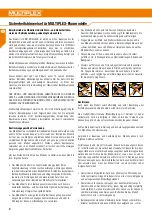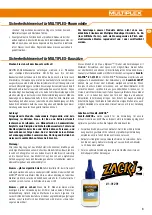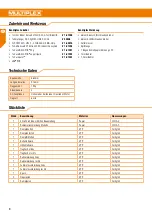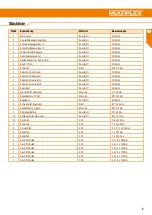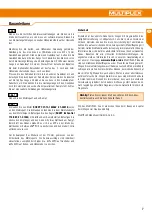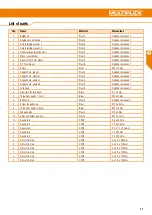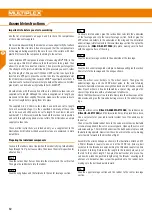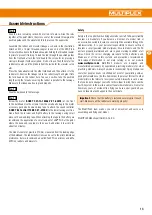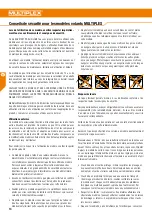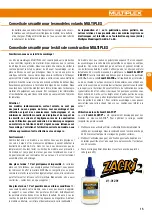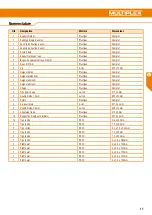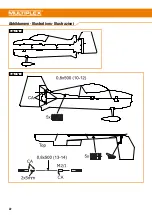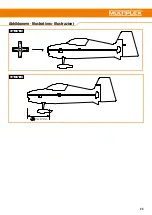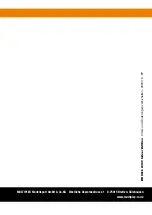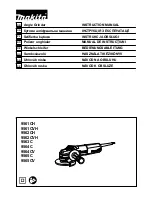
13
Assembly instructions
Fig. 9
Glue the two remaining carbon fiber struts into place. Glue the rods
together at the point where they cross over at the elevator. Now glue the
pushrod guides and the elevator horn into place on the upper side.
Assemble the rudder and elevator linkage as shown in the illustration.
Attach an M2 x 14mm threaded coupler to one end of the CFRP rod.
Screw a fork head onto the threaded coupler, holding the threaded coupler
in pliers to prevent it turning. Thread the rod through the pushrod guides
from the front and attach the fork head to the servo arm by pressing a
clevis pin through it with small pliers. It is best to use the 4th hole for the
rudder servo arm and the 3rd hole from the inside for the elevator servo
arm.
Press the tube adapter into the other fork head and then attach it to the
rudder arm. Shorten the linkage rod to the correct length and glue it into
the fork head on the rudder horn. You can now fine-tune the pushrod
length using the threads; ensuring the rudder is parallel to the fuselage.
Make sure the linkage parts are glued properly.
Fig. 10
Glue the bulkhead to the fuselage.
Fig. 11
Screw the motor (
ROXXY C27-13-1800kV # 1-00018
) at the front
to the bulkhead. Use the screws from the small parts bag in the motor
accessory pack. Use hook-and-loop tape to attach the speed controller
(
ROXXY BL Control 715 BEC # 1-01050
) to the lower fuselage section.
Also attach the receiver and flight battery to the fuselage using small
pieces of hook-and-loop tape. When attaching the tape to the battery, we
recommend the application of a small amount of UHU
®
POR at the point
where the hook-and-loop tape is to be used, and allow it to air-dry for
about ten minutes.
The model’s center of gravity is 210mm, measured from the leading edge
of the bulkhead. The rudder deflections can be set to the pilot’s individual
preference, but we recommend about 80% EXPO on ailerons and 60%
EXPO on rudders and elevators.
Safety
Safety is the top priority when flying any model aircraft. Third-party liability
insurance is mandatory. If you become a member of a model club or
an association, suitable insurance cover might be available through the
club/association. It is your personal responsibility to ensure sufficient
insurance cover (powered model airplane). Ensure models and the RC
unit are properly maintained and are in good working condition at all
times. Check the correct charging procedure for the batteries used.
Make use of all the safety systems and precautions recommended.
Find relevant information in our main catalog or on our website
www.multiplex-rc.de
MULTIPLEX products are designed and
manufactured exclusively by experienced practicing modelers for other
practicing modelers. Always fly models responsibly! Flying models low
over other people’s heads is definitely not proof of your piloting skill, as
good pilots would never do this. Remember to point out this fact to other
model pilots in the interest of everyone’s safety. Always fly in such a way
that you do not endanger yourself or others. Bear in mind that even the
best RC system in the world is subject to outside interference. No matter
how many years of accident-free flying you have under your belt, you
have no idea what will happen in the next minute.
Important:
Check that the battery is fastened securely prior to each
start. Make sure all the rudders are working properly!
The MULTIPLEX team wishes you lots of enjoyment and success in
assembling and flying your model.
MULTIPLEX Modellsport GmbH & Co. KG
EN


